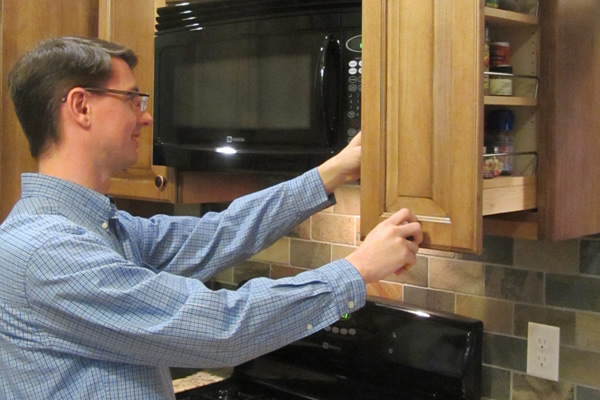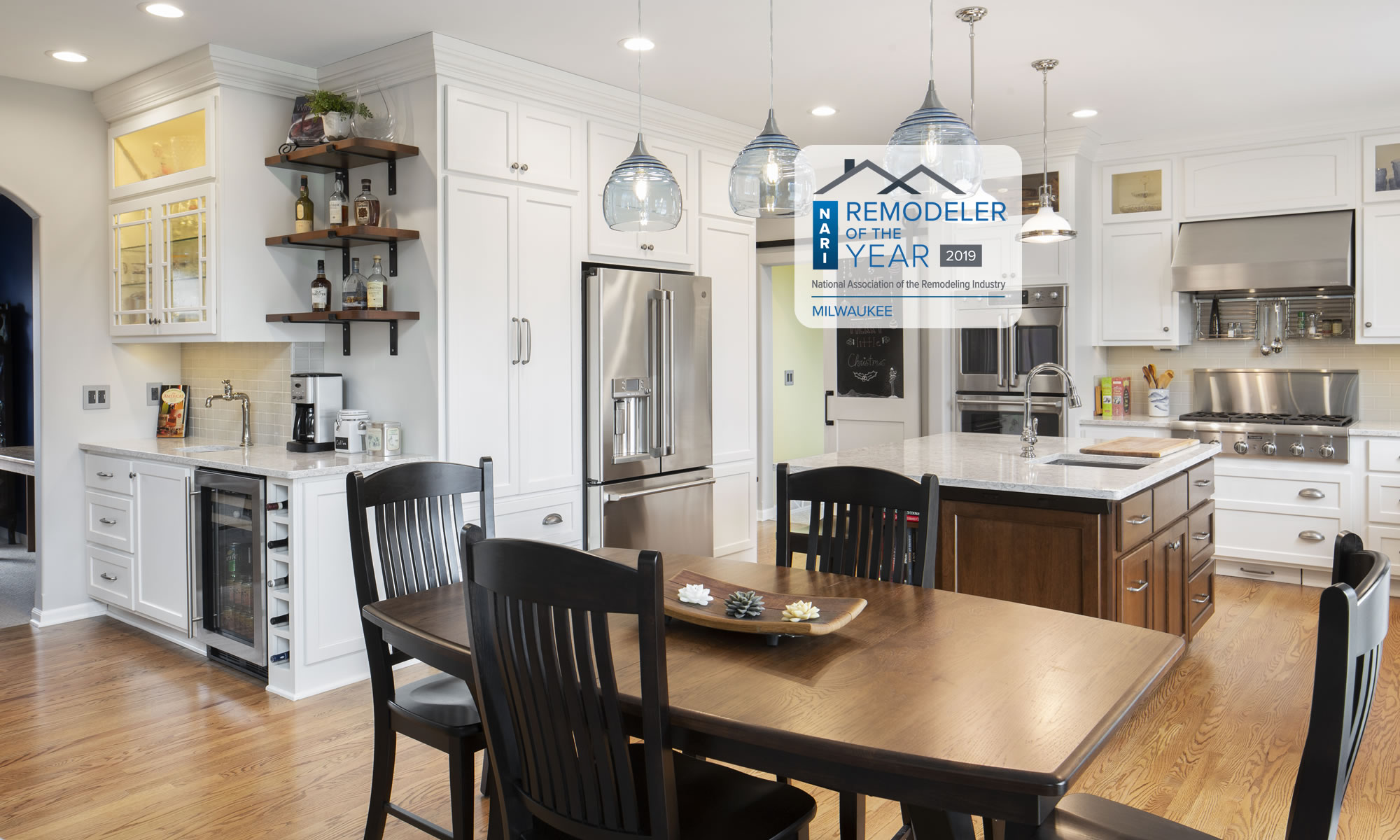
Rick Pues can sit, relax, watch television and cut vegetables all in his living room. No coffee table or other furniture is involved. Pues rolls in a portable cutting block. The 1 1/2-inch-thick hard maple is mounted atop a wheeled cabinet section. He chops, pounds, slices and dices. With the 2-feet-by-2-feet square, there is plenty of space to work. When finished, the piece fits back in line with his kitchen cabinets.
The section’s portability offers alternative options to standing at a kitchen counter. Pues can prepare food anywhere its rolling casters will go. No cutting board is required, putting convenience, function and comfort all in one handy package.
The creation was not born overnight. Pues, who bought his three-bedroom Bay View bungalow in 1998, jokes that he waited 15 years too long to remodel the kitchen.
His patience was rewarded this year. Since January, he has enjoyed cooking and creating in a refurbished, well-appointed kitchen area. Pues is surrounded by new cabinets, new granite countertops, a refinished maple floor, and bright, airy lighting from the ceiling and under-cabinet spaces.
Considered another way, those 15 years allowed Pues to devise some unique ideas. A new kitchen pantry built recessed into a wall was one. The portable cabinet section that fits at the end of the built-in cabinets was another.
Pues originally wanted an island in his kitchen. Its confines would not cooperate. The room was too small and the traffic could not flow, but he did not give up. Pues hired The Cabinet Maker in Oak Creek to remodel his kitchen. When he saw plans for a new bank of lower cabinets, his idea surfaced. The end cabinet section could be a cart.
“It was more than anything being able to have a food preparation area anywhere I wanted it,” Pues said.
The wheeled cabinet piece would be a portable island. He could roll it next to the sink, the oven, into the living room, pretty much anywhere. When not in use, it tucked in next to the other kitchen cabinets.
Pues originally planned to top the cart with granite, to match his new surrounding countertops. John Phillips, of The Cabinet Maker, had another suggestion: How about a thick, durable butcher block surface? Pues quickly saw the wisdom. The heavy wood was virtually indestructible. He would never need a cutting board. The maple block could be periodically sanded and resealed, then returned to use. In short, the hardwood cutting surface would last a lifetime.
“The idea of putting a cutting board on top of the portable cabinet made it much more utilitarian,” Pues said. “You don’t have to put another board on top of it.”
The movable piece is still used as a cabinet. Pues stores pots, pans, a food processor and a pizza oven inside. All are used in food preparation. His goal of a one-stop solution was realized. He admits it took a while to get used to not grabbing a separate cutting board.
“It’s nice to have something you don’t have to worry about destroying,” Pues said.
Many cooks could benefit from this quality of a surface. Cutting and pounding directly on countertops remains is not advised. Doing so risks permanent chips, scratches and incisions in often pricey materials. For those without built-in wood surfaces, a cutting board remains a must-use implement.
“Countertops are made to be used in your home for food preparation, and you have to use common sense,” said Ken Connor of Connor Remodeling and Design in Menomonee Falls. “It’s like a childproof toy – there really isn’t one that’s completely safe.”
Wood butcher block tops remain the most durable cutting surface. Hard-core cooking enthusiasts sometimes build them into counters, Phillips said. Hard maple is the wood of choice. Besides its consistency, the species also poses no risk of nut allergy reactions such as with walnut, he said.
Butcher blocks have to be periodically lubricated. Warning signals include end grain cracking or a dry, weathered appearance. Using varnish is not advised, because it may chip into food. Flaxseed and corn oil are not ideal either.
“Mineral oil is what I recommend,” Phillips said. “The other natural oils can go rancid.”
The traditional pullout wood cutting board is slowly fading away, he said. One drawback is that the board reduces drawer or cabinet space beneath.
In kitchens where pullout boards are still added, their location is usually by a sink or wastebasket. The 1-inch board thickness is supported by heavy-gauge metal slides to withstand the downward pressure of food preparation, Phillips said.
When redesigning kitchens, homeowners usually gravitate to countertop materials with desired aesthetics: the diversity of granite, the shine of stainless steel, or the sparkle of engineered stone, for example.
Ten different materials comprise the lion’s share of counters, Connor said. Some can handle a hot pan. Others resist staining. Each has strengths and weaknesses. All have different maintenance needs.
Like it or not, he said, individuals should not cut or pound directly on any of them.
“You want to protect that beautiful surface,” Connor explained.
Cutting boards are usually located close to food preparation areas. The cookie sheet rack in a base cabinet is typical, he said, or in an island cupboard. An arm’s reach away is ideal.
Some cutting boards borrow from countertops. Corian, a solid surface counter material from DuPont, is regularly used in cutting boards, Connor said.
Some wood cutting boards double as decoration. Different wood species are inlaid in patterns for visual appeal, Phillips said.
Rick Pues did not need anything fancy. While his butcher block cabinet top is attractive, it is also a workhorse surface able to withstand any kitchen tool. Fear of damage is non-existent.
The piece holds a different beauty than his kitchen’s granite countertops. Its mobility is part of its ingenuity. Even though he waited 15 years, Pues ended up with a unique kitchen element that goes where he wants, offering exactly what he needs.
This article, written by Rick Moon of Lunar Communications, was originally published May 18, 2013, in the Milwaukee Journal Sentinel.

